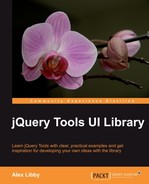"Let's face it—do you really need drag and drop, resizable windows, or sortable lists on your website…?"
If the answer is no, then welcome to "jQuery Tools UI Library"!
jQuery Tools is a compact, powerful library that contains enough components to provide the most important functionality on any website. Many UI libraries contain a myriad of components, such as list boxes, ranges, sortable lists, and the like. While this can be used to build a range of online-based applications that are useful in company intranets, for example, it is not so useful when building normal websites.
Websites are built to present information and to look good—jQuery Tools is designed to enhance any site that uses them, while harnessing the power that modern JavaScript techniques can offer. With jQuery Tools, you are not tied to any predefined HTML, CSS structures, or strict programming rules—you can include the library in your pages and start to use its functionality immediately. The tools are designed to be customized to your liking, while maintaining the core functionality that goes to make up JQuery Tools.
If you're a newcomer to jQuery Tools, and want to explore the functionality available, this is the book for you. With easy to follow step-by-step instructions, you'll find what you need to get you going with using this library, and discover how you can implement some complex functionality, with just a few lines of code.
So let's get on with it...
Chapter 1, Getting Started with jQuery Tools UI Library, introduces you as the reader to the library billed as the "missing UI library for the Web". It explains how to get hold of jQuery Tools, outlines the tools you will need to develop webpages which use this functionality, and outlines some of the best practices to use with jQuery Tools.
Chapter 2, Getting Along with your UI Tools, delves into each part of the jQuery Tools UI library, and how to implement the basic tools into your website. Within each part of the UI library, a walk-through demonstration is included, as well as a more advanced example of what can be achieved using the library.
Chapter 3, Form Tools, introduces the form functionality within jQuery Tools. It outlines how to submit and validate content in a form, as well as entering numbers using RangeInput and dates using DateInput. It also demonstrates how to ensure all content is validated correctly, using HTML5 standards.
Chapter 4, jQuery Tools Toolbox, introduces a small collection of tools which, in most cases, can either be used on their own, or as part of one of the main tools from the Library. It notes that although some of the technologies are becoming outdated (thanks to the modern advances of HTML, CSS3 and JavaScript), they can still perform some useful functions within your projects.
Using jQuery Tools in WordPress is an additional PDF available for download from Packt's website, which accompanies this book. It contains some useful ideas and examples for using jQuery Tools within the confines of a content management system. Although the examples are based around the well-known and popular WordPress™ system, the principles could easily be applied to other, similar systems.
